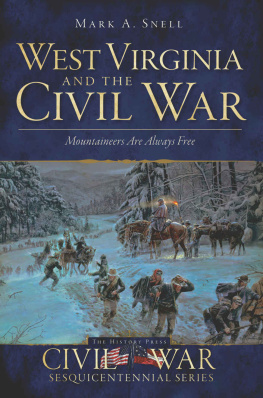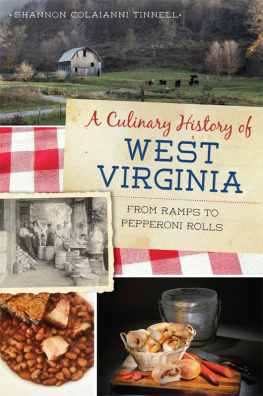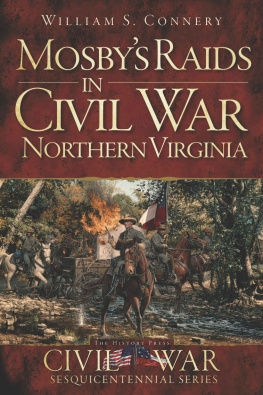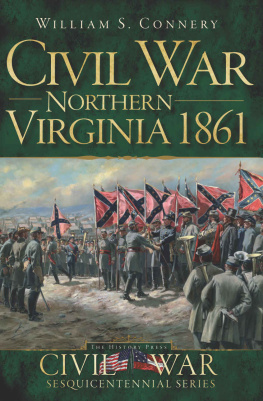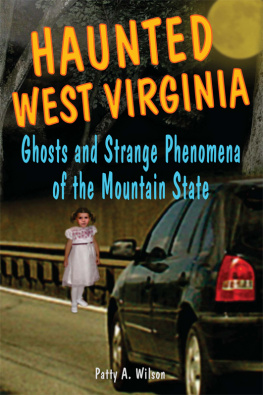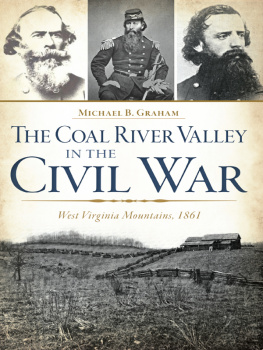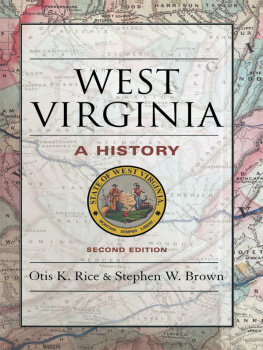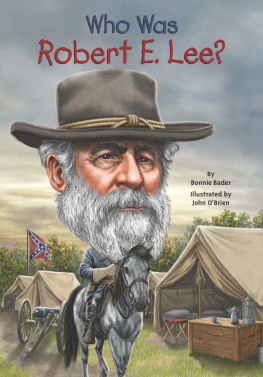
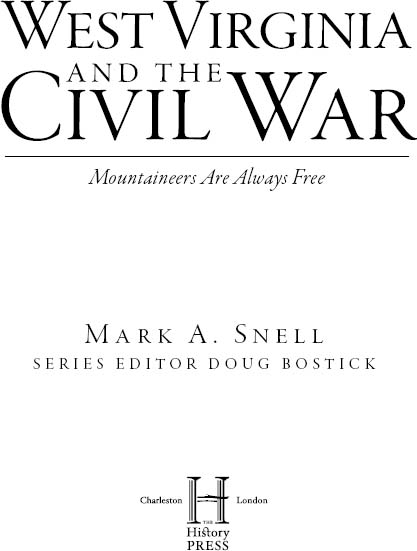
Published by The History Press
Charleston, SC 29403
www.historypress.net
Copyright 2011 by Mark A. Snell
All rights reserved
Front cover: The Winds of Winter by Mort Knstler.
2000 Mort Knstler, Inc. www.mkunstler.com
First published 2011
e-book edition 2012
ISBN 978.1.61423.390.9
Library of Congress Cataloging-in-Publication Data
Snell, Mark A.
West Virginia and the Civil War : mountaineers are always free / Mark A. Snell.
p. cm.
Includes bibliographical references and index.
print edition ISBN 978-1-59629-888-0
1. West Virginia--History--Civil War, 1861-1865. I. Title.
E536.S64 2011
975.403--dc23
2011018583
Notice: The information in this book is true and complete to the best of our knowledge. It is offered without guarantee on the part of the author or The History Press. The author and The History Press disclaim all liability in connection with the use of this book.
All rights reserved. No part of this book may be reproduced or transmitted in any form whatsoever without prior written permission from the publisher except in the case of brief quotations embodied in critical articles and reviews.
For Tom White, Al Pejack, Denise Messinger and all of my past colleagues at the George Tyler Moore Center for the Study of the Civil War
and
In memory of Captain Benjamin Tiffner (U.S. Military Academy, Class of 2000) of Pigeon, West Virginia, the 1999 undergraduate fellow at the George Tyler Moore Center, who, while a detachment commander in the 5th Special Forces Group, U.S. Army, died of wounds received in Iraq, November 7, 2007.
Heres to us and those like us. Damn few left.
Contents
List of Maps
Preface
The Latin motto of the state of West Virginia is Montani Semper LiberiMountaineers [are] Always Free. Yet, when West Virginia was admitted as the thirty-fifth state in the Union, not all of the people who lived there were free. It may be surprising to learn that West Virginia was admitted as a slave state on June 20, 1863. There were, however, conditions attached to that admittance, stipulations that necessitated the gradual emancipation of all slaves within the state. It took another year and a halfin February 1865before the West Virginia legislature finally abolished slavery for all time. This book is the story of West Virginias creation, as well as the people who lived there and their contributions to the war effort, whether they adhered to the Union or supported the Confederacy. It is the first comprehensive attempt to tell that story in nearly fifty years, and I have taken advantage of the many secondary sources that have been published since the Civil War centennial that have focused on West Virginia and its citizens during the conflict, as well as the plethora of published and unpublished primary sources that have surfaced in the last half century. Nonetheless, this volume is only a primer, as an in-depth modern study of West Virginia and the Civil War is yet to be written.
Much of the research for this book was undertaken as part of a larger, multiyear project by my colleagues, the staff members of the George Tyler Moore Center for the Study of the Civil War, a division of the Department of History at Shepherd University, located along the south bank of the Potomac River in Shepherdstown, West Virginia. The centers staff produced an interactive computer program titled Mountaineers of the Blue and Gray: West Virginia in the Civil War (released in 2008), with the intended audience West Virginia secondary-school students. The compilation of the historical data for Mountaineers of the Blue and Gray, over the course of more than a decade, significantly facilitated the research and writing of this current volume. It is to my colleagues, and especially retired U.S. National Park Service ranger Tom White, that I owe gratitude for their assistance in that project, and it is to them that this book is affectionately dedicated.
Even within West Virginia today, the question of whether its statehood was constitutional, and the various answers to that question, can still raise a few hackles. In 2009, at the 200th anniversary commemoration of Abraham Lincolns birth, West Virginia Governor Joe Manchin told me about a conversation with Virginias governor, who jokingly wanted to know when West Virginia was going to return to its legal standing as part of the Commonwealth of Virginia. Governor Manchins response was right to the point: when Virginia pays off West Virginias debt, he replied! The West Virginia governor is still awaiting the commonwealth governors answer.
The historical issues concerning West Virginias role in the conflict and the loyalties of its citizens are just as complex, however, as those relating to the constitutionality of its statehood. For decades, historians downplayed the strong Confederate sympathies in the counties that comprised the new state, deflating the number of men who served in the ranks of the Confederacy while inflating the number of West Virginians who fought for the Union. A few modern historians of West Virginias Civil War heritage have corrected these errors for the most part, but oral tradition and what people choose to remember are sometimes at odds with the historical record, as the last chapter of this monograph attempts to address.
Writing a history about the creation of a new state from an existing state can cause confusion when addressing place names and military organizations. When discussing areas within the current boundary of West Virginia and the military companies and regiments recruited from there prior to June 20, 1863the official date of West Virginia statehoodWestern Virginia or (West) Virginia is used to differentiate between those places and units from those associated from counties within the current boundaries of the Commonwealth of Virginia. After Lincoln signed the statehood bill in December 1862, I normally refer to places within the current boundaries of the Mountain State and Union military organizations attributed to it as West Virginia. Nonetheless, after West Virginias official statehood on June 20, 1863, I continue to call Confederate units that had been recruited from the new state (West) Virginia regiments, battalions or batteries. Another problematic issue is the correct spelling of the last name of the first governor of Reorganized (or, alternatively, Restored) Virginia. Born Francis Harrison Pierpoint, at some point during his adult life he began to spell his name Pierpont (without the second i). During the Civil War, his name was consistently spelled both ways, but to avoid confusion, I use the latter spelling in this book, regardless of how it might have appeared in the referenced secondary sources and primary source documents.
In addition to the staff of the George Tyler Moore Center for the Study of the Civil War, this book would not have been possible without the assistance of many other people, not the least of which include Linda Straub-Bruce, Beth White, Steve Cunningham, Nora Corra, Dr. Richard Sauers, David Phillips, Deborah Spencer, Dr. Victor Thacker, Linda Cunningham Fluharty, Dr. Tom Clemens, Stan Cohen, Dr. Michael Chancey, Reverend John Schildt, Dr. James Holland, Dr. John Stealey, Eric Wittenberg, JD, and above all my friend Major Richard Wolfe (USMC, retired)the most knowledgeable person I know when it comes to the history of West Virginias Civil War soldiers and battleswho read and commented on this manuscript, allowed me to publish photographs from their personal collections, provided scholarly guidance or historiographical advice, donated significant West Virginia sources to the library of the George Tyler Moore Center for the Study of the Civil War or conducted their own research that proved useful in the compilation of this manuscript. At the West Virginia Archives in Charleston, I particularly owe a debt of gratitude to Debra Basham, Terry Lowry, Joe Geiger and Susan Scouras. West Virginia University graduate student Richard Hulver, himself an honor graduate of Shepherd Universitys Civil War Studies Program, assisted me with research and photocopying in the West Virginia University Library. In addition, Dr. Suzanne Shipley, president; Dr. Richard Helldobler, vice-president for academic affairs; Dow Benedict, dean of the School of Arts and Humanities; and Dr. Anders Henriksson, chairman of the Department of History, all at Shepherd University, provided guidance, understanding and moral support. The students in my Shepherd University undergraduate course, History 304, Civil War America, 18501865, also deserve mention, for they listened to excerpts from some of the chapters and kept me straight if my narrative began to sound too academic. I even forced my best friend of many years, retired police officer James Ankrum from York, Pennsylvania, to listen as I read aloud a chapter or two. Considering that it took Jim five years to graduate from our alma mater, York College of Pennsylvania, getting his attention for more than a few minutes at a time was quite an achievement! At The History Press, no author could be more blessed than to have an editor as patient and understanding as Doug Bostick, a fine historian and author in his own right. My copy editor, Diane V. Parham of Columbia, South Carolina, likewise went above and beyond the call of duty, as did Hilary McCullough, editorial department manager at The History Press. I also was lucky to acquire the services of one of the finest cartographers of Civil War maps in the country, my Gettysburg neighbor, Steven Stanley.
Next page
